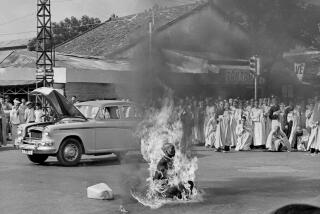MOVIE REVIEW : âBurningâ Looks Back in Anger
Alan Parkerâs âMississippi Burningâ (Cinerama Dome, UA Coronet) does exactly what he wants it to do. It moves us to outrage and horror as it takes us back 24 years to the brave and dangerous dawnings of civil rights activism in Mississippi, the most entrenched segregationist state in the South.
It is fiction patterned on tragic fact, the murder of three young civil rights workers, two white Northerners, Andrew Goodman and Michael Schwerner, and one Southern black, James Chaney, outside Philadelphia, Miss., in 1964.
It is this nighttime killing with which Parker opens his film, point-blank; an excruciating scene, since an entire audience knows its outcome and can only endure anxiously until itâs over. And if, after âMidnight Expressâ or âAngel Heart,â you know Parkerâs flair for violence and over-the-top melodrama, the relative discretion of the scene--far less than the grisly reality of the three murders, especially Chaneyâs--is a blessing.
âMississippi Burningâsâ most powerful achievement is its creation of time and place, done so pungently that the screen never seems free of the threat of danger.
Ultimately it makes the film a shattering experience, particularly for audiences too young to remember the period, or for those of us who knew it, like Vietnam, only from our television screen, from newspapers or from books. Parker makes sure you didnât have to have been in Jessup County to absorb its mood; like kerosene soaking a rag, it permeates every frame of his film.
He captures Mississippi up close and off-guard: its faces, aggrieved, resentful, brimming with hate or blandly, chillingly cheerful. A big-bellied, genial sheriff, who asks FBI agents Anderson and Ward if they are from the âFederal Bureau of Integration.â He shows the far-reaching, disastrous effects of an FBI agentâs misguided act: Walking to the Colored section of a restaurant and speaking to one of the men eating there. And there are flashes of the undeniable charm of the South as well, a waitress answering a question about the food in her fly-specked joint says, âWeâre not full for nuthinâ, sugar,â pitching her reply somewhere between friendliness and innuendo.
Against this real frieze of place and character, screenwriter Chris Gerolmo (âMiles From Homeâ) has concocted a painfully ordinary good-cop/bad-cop scenario. This time they are FBI agents, sent with express orders to solve these disappearances. They are played--exquisitely--by Gene Hackman as Southern ex-sheriff Anderson and Willem Dafoe, as his by-the-books but experienced superior, Ward.
Gerolmo also creates a fictional series of meetings between divorced Southerner Hackman and the equally Southern wife of a sheriffâs deputy whom Hackman patiently woos for her information. They are brilliantly performed; a matter of almost subliminal inferences and subtly understood exchanges between Hackman and Frances McDormand, playing the wife of slimy Deputy Pell (Brad Dourif.) But itâs invention all the same.
Wrangling continually, representing the opposite poles of pragmatism and idealism, Hackman and Dafoe dig and probe and cross-question trying to get a toehold on the truth. And stirred up by their presence, the KKKâs cross burnings and firebombings are redoubled.
Finally, after hideous Klan-led attacks, after beatings and lynchings and attacks on black children, Hackman persuades Dafoe, in effect, that fascism in opposition to racism is no crime, and he embarks on a redneckâs repertoire of retaliation and intimidation. It includes a black FBI agent, brought in to wring information from a white town official, with a spot of kidnaping and threats. The sceneâs dramatic high point, the agentâs account of a castration of a young black man by a Klansman, is one of the pictureâs most sobering moments, but it might be interesting to remember that, historically, the only two blacks in the Bureau at that time were the chauffeur and the maid employed by J. Edgar Hoover. (Audiences may also wince to notice that itâs only after a white woman is endangered that Hackman is moved to action.)
Hackmanâs tactics are also at the heart of the filmâs wrong turn. Parker has said that âMississippi Burningâ isnât about the civil rights movement, but thatâs palaver. It allows Parker and the filmâs marketing department free rein: To have the film be given the respect due to the memories of the three murdered civil rights workers (whose racial and ethnic makeup the filmâs actors mirror), while letting them cry fiction on the other hand, and invent when they please. The argument that film neednât be perfectly congruent with facts, that it can have room to soar free, to deal in symbols and metaphors is certainly reasonable. And in that respect, âMississippi Burningâ is an achievement. It has not exaggerated the horror of that time, when Mississippi was, in effect, a terrorist state, its laws and its bigotry welded together, seemingly permanently.
(For an exhaustive overview, read âWe Are Not Afraid,â by Seth Cagin and Philip Dray, a meticulously documented nonfiction account of the murders, the investigations and the climate of the day.)
However, the victories which are at the heart of âMississippi Burningâ werenât won by razor-wielding redneck FBI agents with their hearts in the right places; to suggest that they were is simplistic and insulting to the hundreds of Southern blacks who clung to nonviolence in the face of assault. Those young people, the very ones who created the civil rights movement, are absent from the film, whose only black Mississippians are victims, hymn-singers and noble children. Nowhere here will you find black leaders or the eloquence, say, of Mississippi CORE chief David Dennisâ eulogy for James Chaney, as passionate and persuasive a piece of Americana as the Sacco-Vanzetti letters.
In the ways of Hollywood, âMississippi Burningâ will probably stand as the film on this subject. In spite of its mortifying omissions, the story is unlikely to be done again. What we have to be grateful for is the filmâs cumulative power, its use of the soaring songs of the time, its catalogue of faces--both black and white--its fire-lit vision of a feudal hell.
If you listen closely to the dialogue, itâs clear that Parkerâs respect for this almost holy period of American struggle is what has expanded upon a pretty pedestrian script, has made it a film of notable images and performances. Yet, given the period, it is still unequal to its subject.
âMISSISSIPPI BURNINGâ
An Orion Pictures release of a Frederick Zollo production of an Alan Parker film. Producers Zollo, Robert F. Colesberry. Director Parker. Written by Chris Gerolmo. Camera Peter Biziou. Editor Gerry Hambling. Production designers Philip Harrison, Geoffrey Kirkland. Art director John Willett, set decorator Jim Erickson. Sound Danny Michael. Costumes Aude Bronson Howard. Original music Trevor Jones. With Gene Hackman, Willem Dafoe, Frances McDormand, Brad Dourif, R. Lee Ermey, Gailard Sartain, Stephen Tobolowsky, Michael Rooker, Pruitt Taylor Vince, Badja Djola, Kevin Dunn.
Running time: 2 hours, 8 minutes.
MPAA-rated: R (under 17 requires accompanying parent or adult guardian).
More to Read
Only good movies
Get the Indie Focus newsletter, Mark Olsen's weekly guide to the world of cinema.
You may occasionally receive promotional content from the Los Angeles Times.










